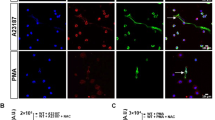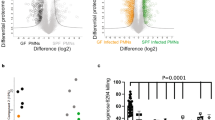Abstract
According to the hitherto accepted view, neutrophils kill ingested microorganisms by subjecting them to high concentrations of highly toxic reactive oxygen species (ROS) and bringing about myeloperoxidase-catalysed halogenation. We show here that this simple scheme, which for many years has served as a satisfactory working hypothesis, is inadequate. We find that mice made deficient in neutrophil-granule proteases but normal in respect of superoxide production and iodinating capacity, are unable to resist staphylococcal and candidal infections. We also show that activation provokes the influx of an enormous concentration of ROS into the endocytic vacuole. The resulting accumulation of anionic charge is compensated for by a surge of K+ ions that cross the membrane in a pH-dependent manner. The consequent rise in ionic strength engenders the release of cationic granule proteins, including elastase and cathepsin G, from the anionic sulphated proteoglycan matrix. We show that it is the proteases, thus activated, that are primarily responsible for the destruction of the bacteria.
This is a preview of subscription content, access via your institution
Access options
Subscribe to this journal
Receive 51 print issues and online access
$199.00 per year
only $3.90 per issue
Buy this article
- Purchase on Springer Link
- Instant access to full article PDF
Prices may be subject to local taxes which are calculated during checkout





Similar content being viewed by others
References
Metchnikoff, B. Immunity in Infective Diseases (Cambridge Univ. Press, 1905).
Sbarra, A. J. & Karnovsky, M. L. The biochemical basis of phagocytosis. 1. Metabolic changes during the ingestion of particles by polymorphonuclear leukocytes. J. Biol. Chem. 234, 1355–1362 (1959).
Mandell, G. L. Bactericidal activity of aerobic and anaerobic polymorphonuclear neutrophils. Infect. Immun. 9, 337–341 (1974).
Babior, B. M., Curnutte, J. T. & Kipnes, R. S. Biological defense mechanisms. Evidence for the participation of superoxide in bacterial killing by xanthine oxidase. J. Lab. Clin. Med. 85, 235–244 (1975).
Babior, B. M., Kipnes, R. S. & Curnutte, J. T. Biological defence mechanisms: the production by leukocytes of superoxide, a potential bactericidal agent. J. Clin. Invest. 52, 741–744 (1973).
Thrasher, A. J., Keep, N. H., Wientjes, F. & Segal, A. W. Chronic granulomatous disease. Biochim. Biophys. Acta 1227, 1–24 (1994).
Klebanoff, S. J. Antimicrobial mechanisms in neutrophilic polymorphonuclear leukocytes. Semin. Hematol. 12, 117–142 (1975).
Belaaouaj, A. et al. Mice lacking neutrophil elastase reveal impaired host defense against Gram-negative bacterial sepsis. Nature Med. 4, 615–618 (1998).
Tkalcevic, J. et al. Impaired immunity and enhanced resistance to endotoxin in the absence of neutrophil elastase and cathepsin G. Immunity 12, 201–210 (2000).
Hampton, M. B., Kettle, A. J. & Winterbourn, C. C. Involvement of superoxide and myeloperoxidase in oxygen-dependent killing of Staphylococcus aureus by neutrophils. Infect. Immun. 64, 3512–3517 (1996).
Aratani, Y., Koyama, H., Nyui, S., Suzuki, K., Kura, F. & Maeda, N. Severe impairment in early host defense against Candida albicans in mice deficient in myeloperoxidase. Infect. Immun. 67, 1828–1836 (1999).
Cross, A. R. & Jones, O. T. The effect of the inhibitor diphenylene iodonium on the superoxide-generating system of neutrophils. Specific labelling of a component polypeptide of the oxidase. Biochem. J. 237, 111–116 (1986).
Segal, A. W., Geisow, M., Garcia, R., Harper, A. & Miller, R. The respiratory burst of phagocytic cells is associated with a rise in vacuolar pH. Nature 290, 406–409 (1981).
Segal, A. W. & Coade, S. B. Kinetics of oxygen consumption by phagocytosing human neutrophils. Biochem. Biophys. Res. Commun. 84, 611–617 (1978).
Hampton, M. B., Kettle, A. J. & Winterbourn, C. C. Inside the neutrophil phagosome: oxidants, myeloperoxidase, and bacterial killing. Blood 92, 3007–3017 (1998).
Bu-Ghanim, H. N., Segal, A. W., Keep, N. H. & Casimir, C. M. Molecular analysis in three cases of X91-variant chronic granulomatous disease. Blood 86, 3575–3582 (1995).
Jiang, Q., Griffin, D. A., Barofsky, D. F. & Hurst, J. K. Intraphagosomal chlorination dynamics and yields determined using unique fluorescent bacterial mimics. Chem. Res. Toxicol. 10, 1080–1089 (1997).
Styrt, B. & Klempner, M. S. Internal pH of human neutrophil lysosomes. FEBS Lett. 149, 113–116 (1982).
Henderson, L. M., Chappell, J. B. & Jones, O. T. The superoxide-generating NADPH oxidase of human neutrophils is electrogenic and associated with an H+ channel. Biochem. J. 246, 325–329 (1987).
Nanda, A. & Grinstein, S. Protein kinase C activates an H+ (equivalent) conductance in the plasma membrane of human neutrophils. Proc. Natl Acad. Sci. USA 88, 10816–10820 (1991).
DeCoursey, T. E., Cherny, V. V., Zhou, W. & Thomas, L. L. Simultaneous activation of NADPH oxidase-related proton and electron currents in human neutrophils. Proc. Natl Acad. Sci. USA 97, 6885–6889 (2000).
Menegazzi, R., Busetto, S., Dri, P., Cramer, R. & Patriarca, P. Chloride ion efflux regulates adherence, spreading, and respiratory burst of neutrophils stimulated by tumor necrosis factor-α (TNF) on biologic surfaces. J. Cell Biol. 135, 511–522 (1996).
Clapp, L. H. & Tinker, A. Potassium channels in the vasculature. Curr. Opin. Nephrol. Hypertens. 7, 91–98 (1998).
Love, W. D. & Burch, G. E. A comparison of potassium42, rubidium86, and cesium134 as traces of potassium in the study of cation metabolism of human erythrocytes in vitro. J. Lab. Clin. Med. 41, 351–362 (1953).
Segal, A. W. & Meshulam, T. Production of superoxide by neutrophils: a reappraisal. FEBS Lett. 100, 27–32 (1979).
Ince, C. et al. Intracellular K+, Na+ and Cl- concentrations and membrane potential in human monocytes. Biochim. Biophys. Acta 905, 195–204 (1987).
Potma, E., de Boeij, W. P., van Haastert, P. J. & Wiersma, D. A. Real-time visualization hydrodynamics in single living cells. Proc. Natl Acad. Sci. USA 98, 1577–1582 (2001).
Aderem, A. & Underhill, D. M. Mechanisms of phagocytosis in macrophages. Annu. Rev. Immunol. 17, 593–623 (1999).
Rizoli, S. B., Rotstein, O. D., Parodo, J., Phillips, M. J. & Kapus, A. Hypertonic inhibition of exocytosis in neutrophils: central role for osmotic actin skeleton remodeling. Am. J. Physiol. Cell Physiol. 279, C619–C633 (2000).
Kolset, S. O. & Gallagher, J. T. Proteoglycans in haemopoietic cells. Biochim. Biophys. Acta 1032, 191–211 (1990).
Odeberg, H. & Olsson, I. Antibacterial activity of cationic proteins from human granulocytes. J. Clin. Invest. 56, 1118–1124 (1975).
Winterbourn, C. C., Garcia, R. C. & Segal, A. W. Production of the superoxide adduct of myeloperoxidase (compound III) by stimulated human neutrophils and its reactivity with hydrogen peroxide and chloride. Biochem. J. 228, 583–592 (1985).
Kettle, A. J. & Winterbourn, C. C. A kinetic analysis of the catalase activity of myeloperoxidase. Biochemistry 40, 10204–10212 (2001).
Guerin, I. & de Chastellier, C. Pathogenic mycobacteria disrupt the macrophage actin filament network. Infect. Immun. 68, 2655–2662 (2000).
Henderson, L. M. & Meech, R. W. Evidence that the product of the human X-linked CGD gene, gp91-phox, is a voltage-gated H+ pathway. J. Gen. Physiol. 114, 771–786 (1999).
Maturana, A. et al. Heme histidine ligands within gp91phox modulate proton conduction by the phagocyte NADPH oxidase. J. Biol. Chem. 276, 30277–30284 (2001).
Nanda, A., Romanek, R., Curnutte, J. T. & Grinstein, S. Assessment of the contribution of the cytochrome b moiety of the NADPH oxidase to the transmembrane H+ conductance of leukocytes. J. Biol. Chem. 269, 27280–27285 (1994).
De Coursey, T. E., Cherny, V. V., Morgan, D., Katz, B. Z. & Dinauer, M. C. The gp91phox component of NADPH oxidase is not the voltage-gated proton channel in phagocytes, but it helps. J. Biol. Chem. 276, 36063–36066 (2001).
McCord, J. M. & Wong, K. in Oxygen Free Radicals and Tissue Damage (ed. Fitzsimons, D. W.) 343–360 (Excerpta Medica, Amsterdam, 1979).
Klebanoff, S. J. & Pincus, S. H. Hydrogen peroxide utilization in myeloperoxidase-deficient leukocytes: a possible microbicidal control mechanism. J. Clin. Invest. 50, 2226–2229 (1971).
Brennan, M. L. et al. Increased atherosclerosis in myeloperoxidase-deficient mice. J. Clin. Invest. 107, 419–430 (2001).
Klebanoff, S. J. & Clark, R. A. Iodination by human polymorphonuclear leukocytes: a re-evaluation. J. Lab. Clin. Med. 89, 675–686 (1977).
Grogan, A. et al. Cytosolic phox proteins interact with and regulate the assembly of coronin in neutrophils. J. Cell Sci. 110, 3071–3081 (1997).
Hall, T. A. & Gupta, B. L. in Principles of Analytical Electron Microscopy (eds Joy, D. C., Romig, A. D. & Goldstein, J. I.) 219–248 (Plenum, London, 1986).
Olsen, R. L. & Little, C. Purification and some properties of myeloperoxidase and eosinophil peroxidase from human blood. Biochem. J. 209, 781–787 (1983).
Sadir, R., Baleux, F., Grosdidier, A., Imberty, A. & Lortat-Jacob, H. Characterization of the stromal cell-derived factor-1–α-heparin complex. J. Biol. Chem. 276, 8288–8296 (2001).
Vita, F. et al. Preparation of membrane fractions from human neutrophil granules: A simple method. Methods Cell Sci. 19, 197–205 (1997).
Barrett, A. J. Cathepsin G. Methods Enzymol. 80C, 561–565 (1981).
Amos, B. J., Pocock, G. & Richards, C. D. On the role of bicarbonate as a hydrogen ion buffer in rat CNS neurones. Exp. Physiol. 81, 623–632 (1996).
Acknowledgements
We thank W. Gratzer, P. Rich, F. Ashcroft, M. Brand, R. Vaughan-Jones and M. Duchen for discussions; E. Hawe for statistical analysis; A. Hankin and E. C. Davis for technical assistance; and A. Scott for illustration and art work. The Wellcome Trust and Chronic Granulomatous Disease Research Trust provided financial support.
Author information
Authors and Affiliations
Corresponding author
Ethics declarations
Competing interests
The authors declare no competing financial interests.
Supplementary information
Rights and permissions
About this article
Cite this article
Reeves, E., Lu, H., Jacobs, H. et al. Killing activity of neutrophils is mediated through activation of proteases by K+ flux. Nature 416, 291–297 (2002). https://doi.org/10.1038/416291a
Received:
Accepted:
Issue Date:
DOI: https://doi.org/10.1038/416291a
This article is cited by
-
NLRP3 inflammasome activation and NETosis positively regulate each other and exacerbate proinflammatory responses: implications of NETosis inhibition for acne skin inflammation treatment
Cellular & Molecular Immunology (2024)
-
Detecting organelle-specific activity of potassium channels with a DNA nanodevice
Nature Biotechnology (2023)
-
Switching to the cyclic pentose phosphate pathway powers the oxidative burst in activated neutrophils
Nature Metabolism (2022)
-
Intestinal immunoregulation: lessons from human mendelian diseases
Mucosal Immunology (2021)
-
Neutrophil Extracellular Traps Serve as Key Effector Molecules in the Protection Against Phialophora verrucosa
Mycopathologia (2021)
Comments
By submitting a comment you agree to abide by our Terms and Community Guidelines. If you find something abusive or that does not comply with our terms or guidelines please flag it as inappropriate.



